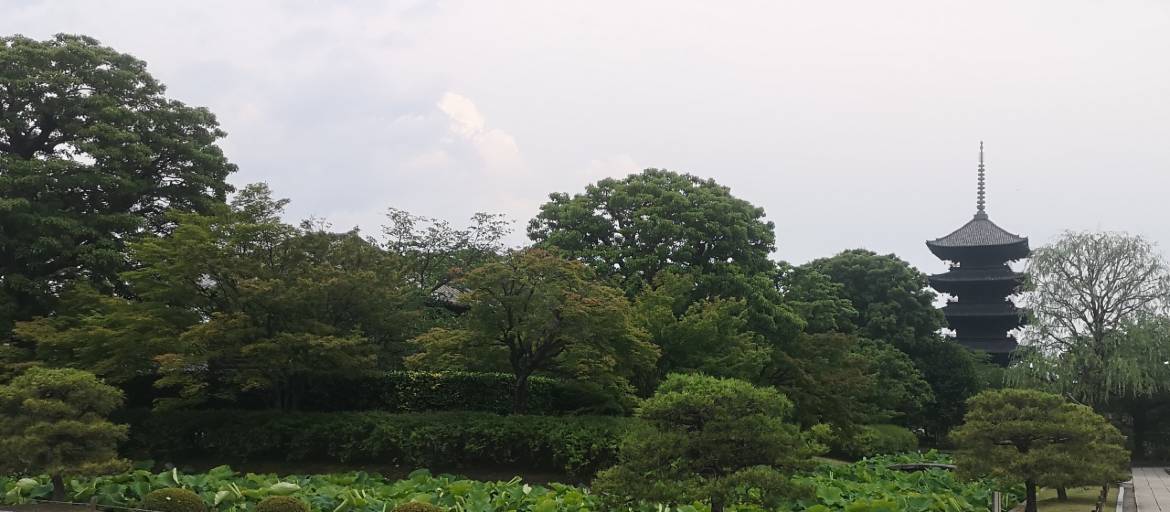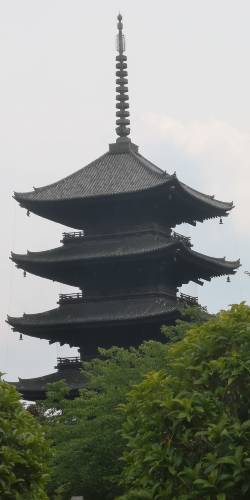Kukai, Emperor Saga, and the Founding of Toji Temple
The Buddhist Channel, 11 June 2023
Kyoto, Japan -- Toji temple, also known as Kyo-o-gokoku-ji or the "East Temple," holds a significant place in the history of Kyoto. When Kyoto became the capital of Japan in 794 CE, only three Buddhist temples were permitted in the city. Toji was one of them. Emperor Kanmu founded Toji in 796 CE and declared it to be "The Temple for the Defence of the Nation by Means of the King of Doctrines." This designation established Toji as a state-sponsored institution, providing divine protection for the nation and its people.

During the early Heian period, Toji temple and its sister temple, Saiji, were built. Unfortunately, Saiji no longer exists, but Toji has endured to this day. As a court-sanctioned temple, Toji houses treasures and documents from the early Heian period and the Tang Dynasty. Its buildings span various periods, including the Kamakura, Muromachi, Momoyama, and Edo periods.
 In 806 CE, Emperor Kanmu's second son, Saga, ascended to the throne as the 52nd emperor of Japan. Emperor Saga was renowned for his skills in calligraphy and his ability to compose Chinese poetry. He was also the first Japanese emperor known to have enjoyed drinking tea. Emperor Saga's passion for poetry and calligraphy led him to forge a friendship with the talented young Buddhist monk, Kukai, also known as Kobo Daishi (774-835). Kukai was a skilled poet and calligrapher himself, and he had gained recognition for establishing a religious community on Mount Koya (Koya-san).
In 806 CE, Emperor Kanmu's second son, Saga, ascended to the throne as the 52nd emperor of Japan. Emperor Saga was renowned for his skills in calligraphy and his ability to compose Chinese poetry. He was also the first Japanese emperor known to have enjoyed drinking tea. Emperor Saga's passion for poetry and calligraphy led him to forge a friendship with the talented young Buddhist monk, Kukai, also known as Kobo Daishi (774-835). Kukai was a skilled poet and calligrapher himself, and he had gained recognition for establishing a religious community on Mount Koya (Koya-san).
Before the emperor met Kukai, the monk embarked on a journey to China in 804 with a Japanese envoy to the Tang Dynasty's courts in Ch'ang-an. During his time there, he studied not only Esoteric Buddhism but also Sanskrit, cultural arts, and civil engineering. Recognizing Kukai's brilliance, Huiguo (746-805 CE), the 7th patriarch of Chen-yen, accepted him as a disciple in 805 CE. Following Huiguo's passing, Kukai became the 8th patriarch of Chen-yen, marking the transmission of Esoteric Buddhism from China to Japan. Upon his return to Japan, Kukai established the Shingon school of Esoteric Buddhism.
Meanwhile, the friendship between Emperor Saga and Kukai flourished. In the winter of 809, Kukai fulfilled the emperor's request to create calligraphy on a pair of folding screens. Over time, Kukai presented the emperor with books of poetry he had copied by hand (811), brushes and writings (812), books on Sanskrit and poetry (814), and screens adorned with his calligraphy (816). Kukai's profound influence on Chinese culture earned him the emperor's patronage, and historians of calligraphy note the marked impact of Kukai on Emperor Saga's writing style.
In 823, Emperor Saga honored Kukai by appointing him as the chief priest of Toji temple. Kukai subsequently transformed Toji into the central seminary of Shingon or Esoteric Buddhism in Japan. He is credited with establishing the first private school in Japan and adding various buildings to the temple, including the pagoda and halls. Toji has since served as the headquarters of the Shingon sect of Japanese Buddhism.
 One of the remarkable features of Toji temple is its famous pagoda, standing at an impressive height of 55 meters. It remains the tallest wooden building in Japan. Although the temple was founded in 796, the pagoda has undergone damage multiple times, and the current structure dates back to 1644. The Kodo Hall, situated in the center of the temple grounds, serves as the lecture hall and houses 21 Buddhist statues, some of the oldest in Japan. The Kondo Hall, one of Toji's original structures, functions as the temple's main hall and largest building. It is also home to Toji's primary object of worship, the wooden statue of Yakushi Buddha. The statue of Kobo Daishi can be found outside the Miedo Hall.
One of the remarkable features of Toji temple is its famous pagoda, standing at an impressive height of 55 meters. It remains the tallest wooden building in Japan. Although the temple was founded in 796, the pagoda has undergone damage multiple times, and the current structure dates back to 1644. The Kodo Hall, situated in the center of the temple grounds, serves as the lecture hall and houses 21 Buddhist statues, some of the oldest in Japan. The Kondo Hall, one of Toji's original structures, functions as the temple's main hall and largest building. It is also home to Toji's primary object of worship, the wooden statue of Yakushi Buddha. The statue of Kobo Daishi can be found outside the Miedo Hall.
Over the years, Toji temple's major buildings suffered damage from earthquakes and fires but have been rebuilt to preserve their original layout and architectural styles. These temple buildings house numerous magnificent treasures, including statues, carvings, paintings, and artworks. In recognition of its historical significance, Toji temple was designated a UNESCO World Heritage site in 1994 as part of the historic monuments of ancient Kyoto.
About Shingon Buddhism
Shingon Buddhism, also known as Esoteric or Tantric Buddhism, holds an important place within the Buddhist tradition. Shingon teaches that enlightenment is attainable within the believer's lifetime through proper training and discipline of the body, speech, and mind. It emphasizes the performance of special rituals, the use of sacred syllables, yoga, and concentration to help practitioners achieve a spiritual state akin to that of the Buddha.


 In 806 CE, Emperor Kanmu's second son, Saga, ascended to the throne as the 52nd emperor of Japan. Emperor Saga was renowned for his skills in calligraphy and his ability to compose Chinese poetry. He was also the first Japanese emperor known to have enjoyed drinking tea. Emperor Saga's passion for poetry and calligraphy led him to forge a friendship with the talented young Buddhist monk, Kukai, also known as Kobo Daishi (774-835). Kukai was a skilled poet and calligrapher himself, and he had gained recognition for establishing a religious community on Mount Koya (Koya-san).
In 806 CE, Emperor Kanmu's second son, Saga, ascended to the throne as the 52nd emperor of Japan. Emperor Saga was renowned for his skills in calligraphy and his ability to compose Chinese poetry. He was also the first Japanese emperor known to have enjoyed drinking tea. Emperor Saga's passion for poetry and calligraphy led him to forge a friendship with the talented young Buddhist monk, Kukai, also known as Kobo Daishi (774-835). Kukai was a skilled poet and calligrapher himself, and he had gained recognition for establishing a religious community on Mount Koya (Koya-san). One of the remarkable features of Toji temple is its famous pagoda, standing at an impressive height of 55 meters. It remains the tallest wooden building in Japan. Although the temple was founded in 796, the pagoda has undergone damage multiple times, and the current structure dates back to 1644. The Kodo Hall, situated in the center of the temple grounds, serves as the lecture hall and houses 21 Buddhist statues, some of the oldest in Japan. The Kondo Hall, one of Toji's original structures, functions as the temple's main hall and largest building. It is also home to Toji's primary object of worship, the wooden statue of Yakushi Buddha. The statue of Kobo Daishi can be found outside the Miedo Hall.
One of the remarkable features of Toji temple is its famous pagoda, standing at an impressive height of 55 meters. It remains the tallest wooden building in Japan. Although the temple was founded in 796, the pagoda has undergone damage multiple times, and the current structure dates back to 1644. The Kodo Hall, situated in the center of the temple grounds, serves as the lecture hall and houses 21 Buddhist statues, some of the oldest in Japan. The Kondo Hall, one of Toji's original structures, functions as the temple's main hall and largest building. It is also home to Toji's primary object of worship, the wooden statue of Yakushi Buddha. The statue of Kobo Daishi can be found outside the Miedo Hall.